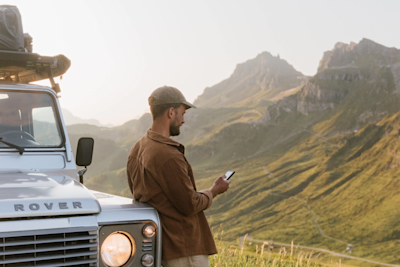
Decluttering Your Emotions
Decluttering your emotions, tidying up your mind and generally organizing your thoughts can help you to keep things simple, so that you can focus on what matters.
You might think that the word ‘clutter’ only really applies to physical objects, such as those found on a cluttered desk, bedroom floor or kitchen countertop. The reality is that clutter can be found in all sorts of places, it can also be digital (when there are too many folders of digital photos to sort out) or emotional (when there are too many things going on in your head at once).
We’ve written a nice post about how to declutter your digital workplace and there’s even one on how to be more minimal at home (which unsurprisingly involves a large amount of decluttering). Hopefully, this post on decluttering your emotions will help you sort out and analyze what’s going on inside your head, in a manageable way.
Track your mood.
Those of you who’ve tried bullet journalling before are probably aware of something called a ‘mood tracker’, this is where you associate a colour with a specific mood and you log your mood on a daily basis using the colour to emotion key. Organizing and understanding your emotions can make a huge difference to your life and help you tackle difficult situations more effectively.
This kind of colour association means that if you're angry you might colour a square red, then happy, green etc. At the end of the month you’re left with a 'colour spectrum of emotions' which will show if a person is generally happy, sad or angry etc. throughout a given month. That way you can analyse and work on why you might feel a certain way!
We might feel different emotions throughout a given day so it’s better to do this at the end of the day rather than at the beginning. You might have a square which is half red (angry at the start of the day) and half green (happy at the end of the day) if something happened to frustrate you and someone cheered you up.
You can even download a printable version of the Mudita Mood Tracker (PDF) so that you’re able to colour it in offline.
Mudita Mood Tracker with colour key suggestions
If you don’t want to use coloured squares, you could also associate your emotions with numbers. Some people find this helpful, you write a list from one to five and then add an emotion, for example:
1 - Happy (Enthusiastic)
2 - Neutral (Content)
3 - OK (Unsure)
4 - Unhappy (Sad)
5 - Very Unhappy (Depressed)
You can have any numbers you’d like associated with any emotions you’d like. If you’d prefer ten numbers associated with ten emotions, go for it. It’s personal to you as an individual so only you can decide what works best.
Be honest with yourself.
There’s no point pretending you’re fine when you’re not. We’ve written a list of questions you can ask yourself, in order to be more honest with yourself. They might enable you to focus a little more on the things that trigger specific emotions within you.
Questions about work:
Do you like where you work?
Do you feel afraid to ask for help or overwhelmed by your workload?
Do you feel as though know what you’re doing or do you require more education or onboarding in terms of your experience?
If you don’t know how to do something, ask someone who knows how to do it to help you, don’t be afraid as the worst they can say is “no”. The same goes for requesting access to courses etc. through your company, training is something all good companies should provide.
Questions about your personal life:
Is everything OK with you on a personal level, with your relationships with loved ones, such as friends, partners, family etc.?
If things aren’t fine on a personal level, it might be hard to handle these problems on your own. Voicing your concerns to someone you trust, who is not directly involved in the situation, means that there may be solutions to problems you wouldn’t have found on your own.
Distancing yourself from an issue is key to working on it. If you’re in the middle of something, it’s very difficult to see the bigger picture, to understand what’s going on around you. Imagine you’re in a maze, surrounded by high walls, the solution is simple and easily seen from above but within the maze, you struggle to find your way out, you go around in circles, taking the wrong turns here and there.
Questions about your well-being:
Are you happy? Yes or no? When was the last time you felt happy? Who or what makes you happy? Why do you think that is?
Are you comfortable? Yes or no? How could you make yourself more comfortable?
Are you healthy? Yes or no? What could you do to improve your health?
Well-being is the state of being healthy, comfortable or happy. (Mudita) Asking yourself questions about your well-being on a daily basis will help you work on making sure you’re as happy, healthy and comfortable as possible. It’ll help you become ‘more human’. Remember that being ‘healthy’ includes mental as well as physical health.
Don’t isolate yourself.
It might be easier said than done not to isolate yourself when you’re feeling a little bit down in the dumps (unhappy). Although alone time is important and can significantly improve how we feel when we finally socialise, in the long run, it’s better to confide in a friend or family member when dealing with something difficult or when you need to get something off your chest.
“Conversely, the absence of social contact also triggers a strong desire to seek social interaction. Social isolation, social exclusion, or feelings of social disconnection can lead to loneliness, which is a strongly aversive emotional state in humans and detrimental to physical and mental well-being (Cacioppo et al., 2006, Cacioppo et al., 2014, Holt-Lunstad et al., 2010, House et al., 1988).”
Photo by Ricardo Esquivel from Pexels
Try writing things down.
‘Dear Diary, …’ Just kidding. There’s no need to keep a journal every day if you don’t want to or if you feel as though it will be yet another thing you have to remember to do. Writing can be a useful way of decluttering our emotions.
Whether it’s writing lists of pros or cons when it comes to difficult decisions or jotting down notes as a way of answering questions such as the ones in this article, a little bit of writing might help.
Think of a time when you felt happy.
There’s a very effective emotional decluttering method you can use when you’re feeling sad. Make sure you have a piece of paper, notebook, napkin (anything you can write on will do) and something to write with (pen, pencil etc.).
Then, think of a good experience, it doesn’t have to be amazing, just a time when you felt good, happy, positive emotions. Write about it. Write down every detail you can remember, if you can’t remember the details (smells, sights etc.), imagine them. Try to combat your feeling of sadness by writing about your feeling of happiness.
Cope with your emotions by comparing them to other things.
‘If a stormy sea was an emotion, it would be …’ is probably going to be followed by ‘anger’. If you think of this when you’re ‘angry’ for example, it might be possible to curb your anger by imagining that the ‘stormy sea’ becomes ‘calm’. If a ‘calm sea was an emotion, it would be … peacefulness.’ Try to come up with your own associations too!
We could also use a technique where you think of how you feel and then you make associations from that feeling. For example, you’re feeling happy, here are some ideas to use:
If [happiness] was a colour, it would be ...
If [happiness] was a song, it would be …
If [happiness] was a place, it would be …
If [happiness] was a taste, it would be ...
If [happiness] was a sight, it would be …
If [happiness] was a smell, it would be …
Which methods have you tried to declutter your emotions? Did you find this article helpful? Is there anything you’d like to add, have we missed anything?
We’d love to know what you think. If you’re interested in sharing your experiences with us or writing a guest post for us, send us an email via hello@mudita.com!
Please feel free to get in touch via social media (send us some photos or videos too), you can find us on Facebook, Twitter and Instagram, let’s connect! To learn more about Mudita, take a look at our website and our other posts. If you enjoyed reading this article, please share and recommend it! We need to go online to find people who’d like to spend more time offline.
Read also: Your Journey to Self-Discovery
Related stories

Why Everyone Is Quitting Social Media
From declining social media engagement to digital fatigue, people are quitting social network platforms. Learn how Kompakt helps reclaim focus and presence.

How Mudita Kompakt Enhances Your Vacation
Mudita Kompakt delivers offline navigation, superb battery life, and zero social media. It's perfect for travelers seeking authentic vacation experiences.

What is a digital detox?
Discover what a digital detox is, why it matters, and how unplugging can boost sleep, reduce stress, and help you reconnect with what really matters.
If you'd like to receive the best stories from our blog, keep up to date with our progress and get notified about our product releases and special discounts.